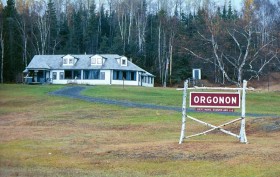A Freudian analyst born in Austria in 1897, Reich was trying to prove the energetic reality of the “Libido” which Sigmund Freud had coined. He worked on his own version of biophysics for many years but by 1933 he left Germany as Hitler’s Nazi regime and the threat to his own well-being increased. After moving to Oslo, he journeyed to the United States in 1939.
The Wilhelm Reich Museum at Orgonon was Reich’s home and workplace. Located in the Rangeley Lakes Region and comprising 175 acres of fields and woodland and two major buildings, the museum represents and interprets his life and work, and the environment in which he investigated the energy functions that he believed govern all living matter.
Orgone is an alleged type of “Primordial Cosmic Energy” discovered by Reich in the late 1930s. He claimed that orgone energy is omnipresent and accounts for such things as the color of the sky and the failure of most political revolutions. In living beings, orgone is called bio-energy or Life Energy.
Reich claimed to have created a new science (orgonomy) and to have discovered other entities, such as bions, which to this day only orgonomists can detect. Bions are alleged vesicles of orgone energy which are neither living nor non-living, but transitional beings.
Among his findings Reich found that unlike most energy forms where potentials flow from higher-to-lower, with Orgone it was the reverse. He argued that the greatest concentrations of Orgone was to be found in water. Eventually, Reich built accumulators big enough to sit in and it was claimed to have noticeable healing results in the cure of mental disorders and cancer.
Reich was charged with criminal contempt because he refused to obey an injunction against selling unproved medical devices such as the Orgone Accumulator and orgone “shooters,” devices which allegedly could collect and distribute orgone energy, thereby making possible the cure for just about any medical disorder.
The Food and Drug Administration not only declared that there is no such thing as orgone energy, they had some of Reich’s books burned–a sure-fire way to ignite interest in somebody.
Reich died in jail of a heart attack on November 3, 1957 while serving the contempt of court charge. Reich’s tomb, with its dramatic bronze portrait bust, stands in a forest clearing near his former home in Rangeley.
Additional resources
Chasseguet-Smirgel, Janine. Freud or Reich?: Psychoanalysis and Illusion. New Haven. Yale University Press. c1986. [University of Maine at Farmington, Mantor Library]
Robinson, Paul A. The Freudian Left: Wilhelm Reich, Geza Roheim, Herbert Marcuse. Ithaca, NY. Cornell University Press. 1990. [University of Maine, Raymond H. Fogler Library]
Sharaf, Myron R. Fury on Earth: A Biography of Wilhelm Reich. New York. St Martin’s Press/Marek. c1983. [University of Maine, Raymond H. Fogler Library, Special Collections; University of Maine at Farmington, Mantor Library; Maine State Library]
The Wilhelm Reich Museum: http://www.somtel.com/~wreich/
The Skeptic’s Dictionary, “Orgone & Wilhelm Reich” http://skepdic.com/orgone.html


